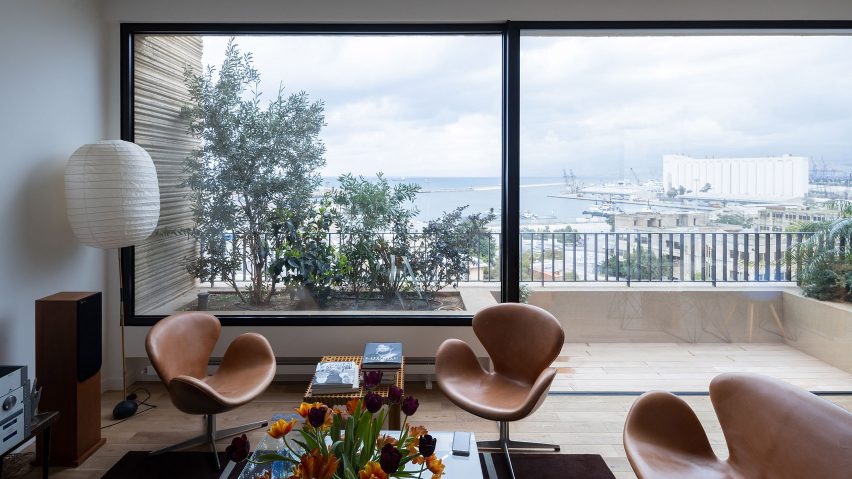Stone Garden is a new apartment block designed by Lebanese architect Lina Ghotmeh that was completed shortly before much of Beirut was devastated by a huge explosion this summer.
Ghotmeh set out to create a building that could symbolise the resilience and long history of the Lebanese capital for her first architecture project in her hometown.
Despite being just one mile from the epicentre of the blast in the city's port, 13-storey Stone Garden survived the explosion with only minor damage.
"I thought it was a tsunami or a bomb, or even a nuclear blast," Ghotmeh told Dezeen.
Standing above the devastation, the sturdy corrugated facade of cement and earth recalls striations in rocks or layers of soil laid down over time. Deep-set balconies are planted with trees and plants, forming individual gardens for residents.
"I grew up in post-war Beirut seeing the city as an open archeology, revealing constantly its guts and all the stories of our ancestors' civilisations who marked this land. From the Phoenicians to the Romans or the Ottomans," Ghotmeh told Dezeen.
The facade is a visual parallel to Pigeon's Rock, a pair of stone formations that rise from the sea that meets the coastal city and feature in Greek mythology.
Ghotmeh designed to Stone Garden to fit with her memories of Beirut after the civil war. "Buildings all bulleted, textures, ruined and yet beautifully invaded by nature," she said. "These buildings look to me like human skeletons, all frail."
To create the ridged effect, the mixture of cement and local earth was hand-combed by artisans working from the bottom to the top.
"I wanted for Stone Garden to be rooted in the ground from which it is emerging. It is attached to the earth of Beirut," said the architect. "It is also an expression of the hands of the artisans that had crafted it."
Stone Garden's openings are irregularly sized and placed around the facade to make the building appear less uniform. Windows and balconies in the apartments have views of the sea.
In contrast to the rough and textured exterior, Ghotmeh designed the interior spaces to be smooth and welcoming – particularly the lobby.
"I drew that space like a womb. It is a rather small intimate space. The side walls are rounded, and the top light feels like a sculpted skylight."
Even before it survived the explosion, Stone Garden was an emotional homecoming for Ghotmeh, whose practice is based in Paris.
"Stone Garden materialises, somehow, my experience of Beirut," she said. "This city that is in constant mishap and that despite it all gives an extraordinary creative energy."
Since the explosion, architects and designers have shared their experience of the disaster and assessed the devastation to their studios and businesses with Dezeen.
Beirut-born type designer Nadine Chahine has commissioned a typeface to help support survivors, and the designers behind Lebanese brand Bokja has turned its showroom into a community centre for people to bring damaged furniture for free repairs.
Photography is by Iwan Baan.
Architect: Lina Ghotmeh
Client: RED
Developer: Pegel Lebanon
Landowners: Fouad ElKhoury, Ilham ElKhou-ry, Marwan ElKhoury
Program: Centre Mina pour l'Image au Moyen Orient
Architect of record: Batimat Architects

